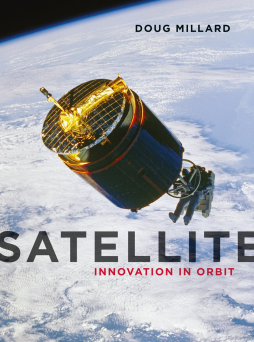
Additional Information
Book Details
Abstract
Right now, above our heads—nearly imperceptible to us but hugely important to how we live—are thousands of man-made objects that we have sent into space. Ubiquitous but mysterious, satellites are the technological infrastructure of our globally connected world, helping us do everything from orient ourselves on a map to watch our favorite television shows. Yet we rarely ever think about them. In this book, Doug Millard pays overdue tribute to the stoic existence of the satellite, tracing its simultaneous pathways through the cold silence of space and the noisy turbulence of the past century.
How satellites ever came to be is, in itself, a remarkable story. Telling an astonishing history of engineering experimentation and ingenuity, Millard shows how the Cold War space race made the earliest satellites—ones like Sputnik, Telstar, and Early Bird—household names. He describes how they evolved into cultural signifiers that represented not only our scientific capabilities but our capacity for imagination, our ability to broaden the scope of our vision to the farthest reaches. From there he follows the proliferation of satellites in the second half of the twentieth century, examining their many different forms, how they evolved, all the things they do, what they have enabled, and how they have influenced our popular culture. Ultimately, Millard asks what we can still expect, what sort of space age the satellite has initiated that is yet to be fully realized.
Published in association with the Science Museum, London, this beautifully illustrated book will appeal to any fan of space exploration and technology.
“This is a fascinating story, not only of satellites themselves but the historical and political context of their birth and development. Through political and other technical developments and drawing on the author’s knowledge through personal contacts, we can appreciate how space has come to transform life as we know it today. While great to keep track of the facts and well-explained technology, this is a good read for anyone interested in our use of space.”
— Helen Sharman OBE, first British Astronaut
“Satellite provides a highly readable account of how we have come to depend on machines in space for many everyday purposes such as weather forecasting, positioning and TV broadcasts as well as for exploring the universe. Doug Millard traces the story from the time of Newton up to the present day laced with anecdotes and wonderful images that make it a treat to read.”
— Pat Norris, author of Spies in the Sky
“Innovations resulting from the use of artificial satellites are a common aspect of everyday life; they are used for communications, television broadcasts, weather forecasting, and global positioning systems (GPS). This book explores the cultural, political, and scientific history of satellites that orbit the Earth and beyond. . . . The work includes many beautiful halftone and color photographs, as well as a time line of satellite history. While the book may be somewhat limited in its approach, space enthusiasts will enjoy it. Recommended.”
— Choice
“Today, satellites are the ultimate example of form following function. A bewildering array exists, but Millard proves a good guide to the various designs and orbits they inhabit. The author has worked at the Science Museum for half the Space Age, his work creating exhibits giving him personal insight into key figures. This well-illustrated book is at its best when he shares such memories, helping personalize an era that, Millard argues, has barely begun.”
— BBC Sky at Night Magazine
“In this nicely produced book, author Millard uses his expertise to summarize the development of spacecraft. The book covers many different aspects of satellites, including their basic design requirements. . . . Highly recommended as an introduction to satellites in all their various guises.”
— Observatory Magazine
“The strengths of Satellite are the clear, accessible exposition of the history, and the rich, well-selected, and numerous illustrations that have been reproduced beautifully (a hallmark of the publisher, Reaktion Books).”
— Metascience
“Illustrated with engaging color photographs. . . . Millard does a good job in showing the merit of satellites for cosmic observation and how they are deployed around other planets. The reader comes away from Satellite with an appreciation of how this technology is as much a part of our ‘infrastructure’ as more earthly engineering creations. Indeed, satellites are so useful and ubiquitous that their number is creating a potential pollution problem in space.”
— Isis
Doug Millard is Deputy Keeper, Technologies and Engineering at the Science Museum, London. He is the author of Cosmonauts: Birth of the Space Age.
Table of Contents
| Section Title | Page | Action | Price |
|---|---|---|---|
| Cover | Cover | ||
| Satellite Innovation in Orbit | 3 | ||
| Imprint Page | 4 | ||
| Contents | 5 | ||
| Introduction | 7 | ||
| 1. Satellites of the Mind | 15 | ||
| 2. The Satellites are Coming | 42 | ||
| 3. Satellites for Real | 65 | ||
| 4. Satellites for All | 103 | ||
| 5. Science of Satellites | 131 | ||
| 6. Science with Satellites | 161 | ||
| Timeline | 187 | ||
| Select Bibliography | 191 | ||
| Acknowledgements | 195 | ||
| Photo Acknowledgements | 197 | ||
| Index | 199 |
